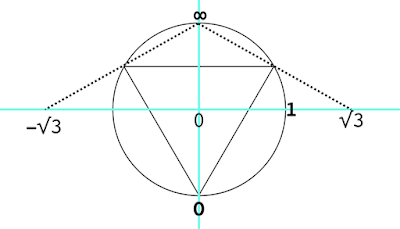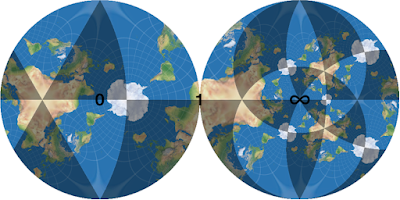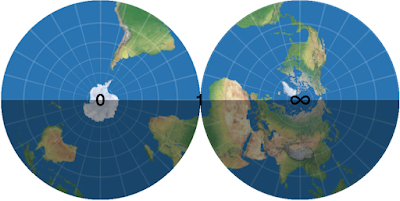For some purposes it is preferable to have ramification points that are equally spaced in the geographic metric, for example, ramification points located at {0, ±√3} (see diagram above) rather than at {0, 1, ∞}. These will not be Belyi functions, but will have analogous uses. For example, if the three points of ramification are equally spaced around the real-number great circle, their colors can be permuted without the geographic distortion found in four of the vertex-color permuting Belyi functions.
Therefore, it may be desirable to find the unique Mobius transformation, S, that maps {0, 1, ∞}, respectively, to {-√3, 0, √3}; and its inverse, S-1, as well. It is easier to start with the inverse since it is a mapping to {0, 1, ∞} like we saw in the previous post, in this case:
z0 = -√3
z1 = 0
z∞ = √3
S-1(z) = ((z-z0)*(z1-z∞))/((z-z∞)*(z1-z0))
= ((z+√3)*(-√3))/((z-√3)*(√3))
= -(z+√3)/(z-√3)
= (-z-√3)/(z-√3)
So: a = -1; b = -√3; c = 1; d = -√3
From Michael P. Pitchman's web chapter on Mobius transformations:
So, S(z) = (√3*z-√3)/(z+1) = √3*(z-1)/(z+1
Domain-coloring visualization of S:
Domain-coloring visualization of S-1:
Domain-coloring visualization of their composition (Identity):
Domain-coloring visualization of S∘Tetrahedron∘S-1:
In the above view of a tetrahedron, the North Pacific now represents vertices, Antarctica now represents mid-edges, and the Sahara represents face centers. It's easy to see that there are four faces (Sahara's) and six edges (Antarctica's), but the four vertices (North Pacifics) are harder to see.















